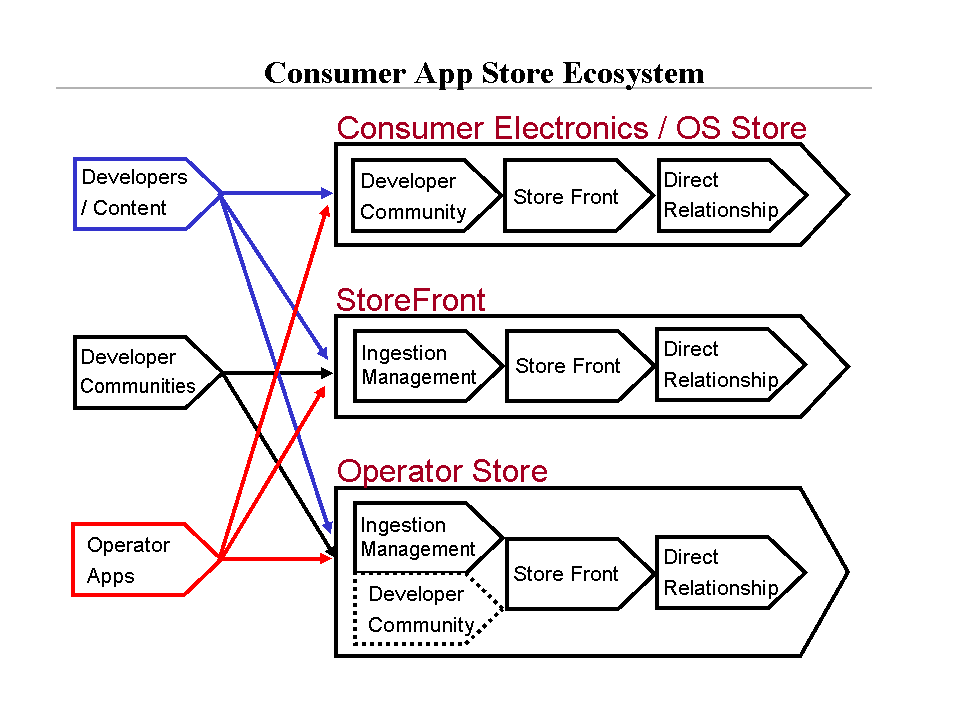There are 4 main application store provider categories:
- Operating System: Google Android, Microsoft Mobile
- Consumer Electronics: Apple, Nokia (Ovi), RIM, Sony, Nintendo, Microsoft Xbox
- Mobile Storefronts: Getjar, Handango, and in the future Amazon (they’ve already started with Kindle)
- Operator: Vodafone (Live), OrangeWorld, O2 Active
Though the term app store is not entirely correct, as some stores includes content (ringtones, movies, music, etc.), games, and bookmarks (widgets); the name has stuck and its a good as any. The app stores have different foci, e.g. Apple is widgets and games, not broader content, that’s through iTunes. Nokia Ovi is virtually everything. And operator stores have traditionally focused upon content, though some operators have recently brought in a separate widget engine, e.g. T-Mobile’s web’n’walk widgets – which is a browsing experience optimized for mobile. A widget is like a bookmark with the page’s code preloaded, so only the user specific or new data is downloaded, speeding downloads and improving user experience. Other stores like Getjar provide games and applications (not content or widgets) to a broad range of devices including the myriad of JavaME devices, while Handango focuses on smartphone games and applications.
A technical point I want to mention is widget engines are not application stores, they are simply a way to make browsing the web by a mobile phone easier. App stores are inherently proprietary to solve the problems of security, DRM (Digital Rights Management), application signing, and performance. iPhone, Windows Mobile, Blackberry, Google Android, NokiaOvi, and Yahoo Mobile are have proprietary app stores. An operator may use a browser with a W3C widget engine to improve the web experience, but they’re going to need to build a proprietary app store around a browser – just like Apple did with iPhone.
Because the CE / OS (Consumer Electronics / Operating System) run on proprietary OSs this requires them to build a dedicated application development community. Its important to note operators have been selling content through WAP browsers, SMS and ODPs (On Device Portal) for many years without an operator specific developer community because the Java and Symbian development communities solved that problem for them. This is a key point, a $31B mobile content market exists without the need for an operator to create a dedicated developer community.
In examining the app store ecosystem shown in the diagram below, CE / OS app stores now have a direct consumer relationship. Once operators struck the deal with Apple, Pandora’s box was finally opened for direct customer access. Some CE/OS stores , e.g. Nokia’s Ovi, claim they will work with the operator’s billing engine (generally premium SMS through an aggregator) which can double the price a customer pays for an app, so customers will likely choose a direct billing relationship or use prepaid gift vouchers like Apple.
In the customer’s buying decision for an iPhone or a Google phone the app store is front and center of the user experience (UE) and proposition. For Operators the app store has not had such prominence in either the UE or proposition; hence its much lower engagement. But this is changing with the larger operators such as Vodafone, Orange, Verizon, etc. making significant investments.
Examining the consumer ecosystems in the diagram below, I break the market into 3 segments CE/OS, storefronts and operator stores. You’ll see I highlight operators can use all channels to market for their applications, e.g. remote control of DVR, web based service management, conference calling, yellow / white pages. Currently operator do not use these channels,
which I’ve discussed in this article. This demonstrates they’re still thinking like network operators not service providers. The Mobile Storefronts and Operators do not require dedicated developer communities as they use standards based platforms, generally they ingestion content from developers direct and partner with developer communities, e.g. Sun’s Java mobile and embedded community, Microsoft’s developer network, Oracle’s technology network, Ericsson’s Mobility World, etc. We’re seeing some of the larger operators build their own communities, but it remains unclear whether this is really necessary.

Looking to the future, the CE/OS stores will continue regardless of commercial sucess as its needed to sell the devices, as that’s where the money is made. Mobile Storefronts have a few options: build the brand to be recognized as the preferred mobile store (difficult once Amazon gets in on the act), consolidate, or partner with operators to provide a white label turnkey store solution. Either way their customer relationship is secondary compared to that of the CE/OS or operator stores.
Operator developer communities are the current focus of experimentation, the larger operators are placing their bets. And some are open to other operators joining their ecosystem, as announced by Steve Glagow of Orange Partner at the Smart Pipes conference last month. The key will be to deliver an integrated experience to the customer, like Apple iPhone, with a single interface for all content, applications, widgets and services.
This isn’t an ‘either-or’ app store battle, customers happily use multiple website for buying their goods, e.g. Amazon, Barnes and Noble, JR.com, etc. And customers even spend time visiting several stores to buy their groceries, e.g. Safeway, Costco, the Sunday farmer’s market, and the local deli for that great pastrami. Hence customers will accept and use multiple stores on the phone.
The battle comes in delivering an integrated experience on the phone. The device and OS stores have the edge over the operators’ stores. Hence why JIL (Joint Innovation Lab, discussed in the Smart Pipes conference) is focused on building its own app store and leveraging its combined purchasing power to influence some handset manufacturers to play fair. In the interim while the “chess pieces” are being moved in the industry, smaller operators can do much with their existing content stores to grow a $31B market into a $100B market through improving the user experience by copying some of Apple’s app store features and using the CE/OS stores to sell their applications because they’re service providers not just network operators!